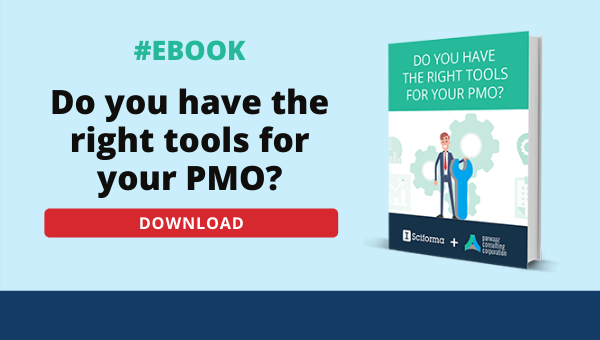Technology is wonderful. In a matter of years, disruptive Information Technology has transformed the way we live and work. It has simplified and augmented our lives, while streamlining a variety of business processes across a range of industries and disciplines. Enterprise Project and Portfolio Management (EPPM) is one of them. Dedicated EPPM software tools and platforms now enable Project Managers, Portfolio Managers and PMOs to get things done better, faster, cheaper.
Listed below are 10 of the most important reasons why your business needs to rely on an EPPM tool to optimize its process and achieve business outcomes.
#1: EPPM Tools and Data Visibility
A professional EPPM tool comes with a database designed to accommodate all of your project and resource data. You get to centralize your information into a single repository offering a single version of the truth. This means that you can bid farewell to the convoluted information sharing process and to the data duplicates or discrepancies that plague a vast majority of the PMOs who try to perform consolidation using Excel or similar tools. Where countless versions of the same documents used to go back and forth between teams, everything now automatically consolidates and updates in real time.
With the ability to store a huge variety of project-related documents in a single platform, you can start building up a central project library that every team member across the business can access easily and instantly.
Industry-grade PPM tools can also interface with other pieces of software, such as an ERP or a PLM, to automate the collection and reconciliation of data across systems. Additionally, PPM platforms offer an audit trail which provides a detailed, documented history of all operations across past activities. By giving you historical perspective, this will let you leverage the lessons learned from past experiences in order to avoid repeating the same mistakes.
Most importantly, this superior data visibility spreads throughout the company. Not only can the PMO know with certainty who is doing what across projects and teams; every project leader or manager, head of department, or resource manager also stands to benefit from improved clarity and insight into the data.
#2: Enterprise Project and Portfolio Management Tools and Productivity
PPM tools will help you define and implement standard processes for project management and task tracking in order to optimize your workflow. What more, they support the automation of all the administrative and repeatable tasks that waste the valuable time of your teams. Did you know that up to 90% of the tasks performed in the workplace have no value-added whatsoever? Well, your PPM tool will take that drudge out of the daily work of your team members and empower them to apply their skills and talent to the remaining, valuable 10%.
In addition to boosting the performance of project teams and the productivity of work — and ultimately your bottom line — automation limits the risk of human error and improves the accuracy of project management. Even for value-added operations that require the judgment and creativity of human workers, the ability to rely on the support of a robust PPM tool can drastically improve project performance and success. The reasons why projects may fail are many: behind deadline, over budget, out of scope… Improved reliability of operations will go a long way towards helping you make sure that your projects don’t miss the mark and turn into successful endeavors.
#3: PPM Tools and Team Collaboration
The various tasks that compose a project usually involve several team members, who should be working in unity. In organizations equipped with a Project Portfolio Management tool, project leaders can just use the platform to assign all the tasks, then monitor progress and coordinate the work. A seamless workflow enables the whole team to work as one, increasing overall effectiveness and opening the door to upskilling and cross-skilling.
Specific features and functionality of PPM tools intend to enable the spread of more collaborative work practices: for example, integrated collaborative workspaces, chat interfaces, the ability to post comments and notes on projects and tasks, automatic notifications, and more.
For organizations engaging in Agile or hybrid project management, dedicated interfaces, such as virtual Kanban boards help keep everyone get up to speed and on the same page at all times.
Along with other functionalities such as shared calendars, collaboration-oriented features facilitate the coordination, communication and organization of meetings. This supports cohesion within a team and enables easier remote communication for geographically-distributed teams — which is of key importance in the current business environment. Overall, inadequate employee communication costs companies with a headcount of 100 employees an estimated average of $420,000 a year. For larger businesses, the average loss soars to a staggering $62.4 million per year.
#4: Enterprise Project and Portfolio Management Tools and Resource Optimization
In practice, employees — and particularly those with sought-after critical skills — are often assigned to multiple projects or tasks. A challenge for PMOs, portfolio managers and resource managers is to avoid overloading their project teams. Stretching resources too thin may result in disgruntled teams, causing a decline in engagement and productivity.
To avoid such a scenario, Project Portfolio Management software assists in the optimization of resource allocation. PPM platforms maintain a comprehensive and detailed list of available resources, with the ability to filter by attributes, and show the actual resource capacity with different levels of granularity — at the scale of the company, of a department or a team.
They also consolidate the resource needs of the various projects and automatically connect the dots, enabling easier and faster allocation decisions.
Since a PPM tool also makes it possible to score and rank projects, it helps both the PMO and project teams to make smarter resource allocations decisions based on project priorities.
Predictive resource management capabilities give portfolio managers a sneak peek into the future state of resource utilization, helping them take proactive action to ensure optimal utilization of capacity over time.
#5: EPPM Tools and Insightful Planning
The planning phase is perhaps the most intricate and critical stage of a project. It requires taking into account a wide array of factors: milestones, deadlines, priorities, risks, and so forth. You need to map out all the various phases and steps, taking into account constraints and dependencies, and establish realistic schedules to make sure you attain your project’s deadline. And you need to make it right. If your assumptions are off base, your projects are unlikely to deliver the expected results.
For these reasons, performing accurate and realistic planning is not only complex; it is also time consuming. Project Portfolio Management tools help define reliable timelines and roadmaps for projects in order to pave the way for effective and efficient completion.
Useful tool functionality include modules enabling multi-project planning, with features showing the links between projects, or scenario simulations to look into the future.
Libraries of pre-filled project models based on lessons from the course of past projects can increase the granularity and reliability of planning decisions, while facilitating and accelerating the process significantly. These templates can be fed information from the time tracking and management modules that collect data regarding the time spent on each task, which will vastly facilitate planning for future projects.
#6: EPPM Tools and Financial Optimization
Let’s talk money. After all, it is at the crux. You just can’t afford to squander your organization’s limited financial resources: make sure that your valuable dollars are spent optimally and generate the highest payback.
First of all, a PPM tool will help you select the most valuable projects from a financial return perspective: you can assess the projected return of various candidate initiatives against a number of financial KPIs and quantitative metrics, and pick the most profitable ones.
Additionally, budget management features will assist in optimizing budget allocation across projects and portfolios. They also track costs and expenses automatically, with alerts in case of potential overruns, which helps PMOs make sure everything is in control and perform adjustments if needed. All in all, according to a PMI study, 66% of businesses using a project management tool complete their projects within budget, compared to 47% of companies without such a tool.
#7: Enterprise Project and Portfolio Management Tools and Risk Mitigation
Risk should always be incorporated into the value calculations that guide the selection of the projects to be launched by the company. Project Portfolio Management software helps determine the feasibility of projects given the resources and budget available, factoring in technology risk, financial risk, systemic risk, and so on.
Your system can detect potential problems or conflicts and make them visible through clear reports and dashboards or automatic alerts. This will enable you to take action early and respond quickly in order to support failing projects before they slip into the red zone.
When problems do occur — because they always do, don’t they? — the visibility and insights brought to you by a tool help you solve them faster, decreasing the risk of project failure.
#8: Enterprise Project and Portfolio Management Tools and Project Selection
In Project Portfolio Management just like in life, you can’t have it all. The limited nature of an organization’s resources makes it necessary to select the projects you’ll run very carefully. PMOs need to make sure that the projects they invest their time, funds and resources in are the most valuable. While value encompasses financial return, that’s not all that there is to it. It should also take in consideration the organization’s vision and long-term goals. Sometimes, a project with a comparatively lower ROI will still need to be prioritized — if it opens up new avenues for growth for example.
The idea and demand management features of a PPM software tool allow you to sort, filter, score, rank and prioritize what you should be doing — now, tomorrow or next year — against a set of custom criteria.
All in all, PPM software enhances the quality and reliability of trade-off decisions. Because your decisions are informed by comprehensive sets of accurate and up-to-date information, they tend to be smarter.
#9: EPPM Tools and Portfolio Management
With a robust Project Portfolio Management tool, you can easily create, review and manage collections and grouping of projects as programs and portfolios. The goal is to maximize the value at the level of the company.
It helps you build solid, consistent portfolios by showing how individual projects may be interdependent and by synchronizing schedules, with N – N relationships views. The simulation of several “what-if” scenarios across multiple portfolios, with the option to compare the simulations both between themselves and with ongoing projects, will help you define the best course of action.
PPM platforms provide a structured framework for performing a full array of activities related to your portfolios of projects: actions, change requests, issues, risks can be managed and monitored at the scale of the whole portfolio. With ongoing assessment and evaluation of the portfolio’s health and performance, you can make sure that the overall investment supports the strategic priorities of your firm. When revisions to the portfolio are warranted, dynamic optimization capabilities allow you to reprioritize or even deselect initiatives to respond to changes in the business environment or priorities.
Finally, program- and portfolio-level analytic reports and dashboards are increasing transparency and visibility to support decision-making.
#10: EPPM Tools and Strategy Alignment
Project portfolios are the best vehicles to materialize the strategy that has been formulated by your organization, and PPM platforms are perhaps the best tools to make this happen.
As PPM software tools facilitate the flow of information across the business and assist in selecting the projects with highest potential value against your specific goals and objectives, they drive optimal alignment between project investments and the objectives of the enterprise.
So, PPM tools provide quality data that assists in the formulation of insightful strategies; they also help translate these strategies into tangible outcomes. That closes the loop and wraps it up.
The case for acquiring a tool is quite compelling. Project Portfolio Management software will address most of the needs and challenges of project organizations, from planning to resource optimization to budget adherence.
But deciding to procure a PPM solution is just the start: you will need to convince your organization’s executives of the importance of your tool procurement initiative by presenting a solid business case backed by ROI calculations. Only then can you start browsing the market to find the tool that is right for your organization.
Key Takeaways:
- Project Portfolio Management Tools perform a wide range of business functions designed to help organizations compete more successfully.
- Among the benefits are increased visibility and productivity, better team collaboration, smarter project planning and resource allocation, financial optimization and risk mitigation and, last but not least, the ability to select and prioritize projects in order to build optimal portfolios and achieve strategy alignment.
For more information on PPM tools we suggest reading:
- How to get more value out of your Project Management tool?
- Why Project Portfolio Management Software is the Future of Business
- What are the criteria to evaluate PPM tools?







Valerie Zeller
Valerie is Sciforma Chief Marketing Officer. Main interests: digital transformation, change management, strategy execution. Send your thoughts @valeriezeller